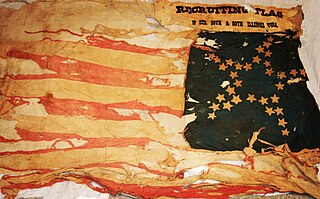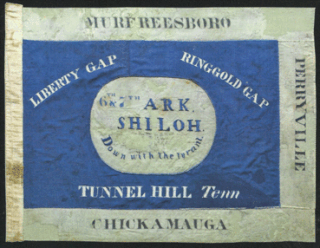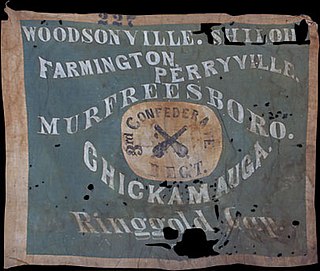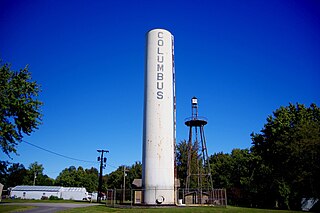
During the American Civil War, the Union Army referred to the United States Army, the land force that fought to preserve the Union of the collective states. Also known as the Federal Army, it proved essential to the preservation of the United States of America as a working, viable republic.
The 95th Regiment Illinois Volunteer Infantry was an infantry regiment that served in the Union Army during the American Civil War.

The 80th Illinois Volunteer Infantry Regiment was an infantry regiment that served in the Union Army during the American Civil War. The regiment was composed of ten companies that drew primarily from eight southern Illinois counties. Over the course of the war the regiment traveled approximately 6,000 miles, and was in over 20 battles.

The 33rd Regiment Illinois Volunteer Infantry was an infantry regiment that served in the Union Army during the Civil War. It fought mainly in the states bordering the Mississippi River, and at the decisive fall of Vicksburg, Mississippi.

The 9th Regiment Illinois Volunteer Infantry was an infantry regiment that served in the Union Army during the American Civil War.
The 17th Regiment Illinois Volunteer Infantry was an infantry regiment that served in the Union Army during the American Civil War.
The 47th Regiment Illinois Volunteer Infantry was an infantry regiment that served in the Union Army during the American Civil War.
The 66th Illinois Veteran Volunteer Infantry Regiment originally known as Birge's Western Sharpshooters and later as the "Western Sharpshooters-14th Missouri Volunteers", was a specialized regiment of infantry sharpshooters that served in the Union Army during the American Civil War. The regiment was intended, raised, and mustered into Federal service as the Western Theater counterpart to Army of the Potomac's 1st and 2nd United States Volunteer Sharpshooters.
The 38th Regiment Alabama Volunteer Infantry was an infantry regiment that served in the Confederate Army during the American Civil War.

6th Arkansas Infantry Regiment was an infantry formation in the Confederate States Army during the American Civil War. Organized mainly from volunteer companies, including several prewar volunteer militia units, raised in the southern half of Arkansas, the regiment was among the first transferred to Confederate Service. It served virtually the entire war in Confederate forces east of the Mississippi River. After the unit sustained heavy casualties during the Battle of Shiloh and Bragg's Kentucky Campaign, the unit spent most of the rest of the war field consolidated with the 7th Arkansas Infantry Regiment, to form the 6th/7th Arkansas Infantry Regiment.
Isaac Campbell Pugh was a United States volunteer soldier who was a veteran of the Black Hawk War, the Mexican–American War and the American Civil War; rising to the rank of Brevet brigadier general.
The 13th Arkansas Infantry (1861–1865) was a Confederate Army infantry regiment during the American Civil War. Organized mainly from companies, including several prewar volunteer militia companies, raised in northeastern Arkansas, the regiment was among the first transferred to Confederate Service, and spent virtually the entire war serving in Confederate forces east of the Mississippi River. After the unit sustained heavy casualties during the Battle Murfreesboro, the unit spent most of the rest of the war field consolidated with the 13th Arkansas Infantry Regiment, to form the 5th/13th Arkansas Infantry Regiment.

The 7th Arkansas Volunteer Infantry (1861−1865) was a Confederate Army infantry regiment during the American Civil War composed of troops from northeast Arkansas. Organized mainly from companies, including several prewar volunteer militia companies, raised in northeastern Arkansas, the regiment was among the first transferred to Confederate Service, and spent virtually the entire war serving in Confederate forces east of the Mississippi River. After the unit sustained heavy casualties during the Battle of Shiloh and Bragg's Kentucky Campaign, the unit spent most of the rest of the war field consolidated with the 6th Arkansas Infantry Regiment, to form the 6th/7th Arkansas Infantry Regiment.

The 18th Arkansas Infantry (Marmaduke's) (1861–1865) was a Confederate Army infantry regiment during the American Civil War. The unit was also briefly identified as the 1st Arkansas Infantry Battalion. The unit was most often referred to as the 3rd Confederate Infantry Regiment. The designation "Confederate Infantry Regiment" was intended to convey the difference between Provisional Confederate Army units and Regular Confederate Army Units, with Provisional units being those regiments who received a state designation such as "XX Arkansas Infantry Regiment". In practice, the designation was most often utilized when Regiments were assembled utilizing companies from more than one confederate state. The "3rd Confederate Infantry Regiment" is occasionally misidentified as the 3rd Arkansas Infantry Regiment commanded by Colonel Van H. Manning.

The 9th Arkansas Infantry was a Confederate Army infantry regiment during the American Civil War. It served throughout the war in the western theater, seeing action in the Vicksburg, Tennessee and Georgia campaigns. Following its depletion in numbers the regiment was consolidated several times with other Arkansas regiments, finally merging in 1865 into the 1st Arkansas Consolidated Mounted Rifles.
The 12th Arkansas Infantry (1861–1865) was a Confederate Army infantry regiment during the American Civil War. The regiment spent much of its service defending Confederate strong points along the Mississippi River. The unit participated in the defense of Island No. 10 in early 1862 and later became part of the garrison of Port Hudson in 1863. Following the capitulation of the garrison of Port Hudson, the survivors of the 12th were eventually paroled and exchanged back to Arkansas where the regiment was consolidated with the remnants of several other Arkansas regiments to become the 2nd Arkansas Consolidated Infantry Regiment.
The 14th (Power's) Arkansas Infantry (1861–1865) was a Confederate Army infantry regiment during the American Civil War. Two Arkansas units received the designation 14th. The other 14th Arkansas Infantry Regiment was commanded by Colonel James H. McCarver. The unit participated in the Pea Ridge Campaign in Arkansas and then moved east of the Mississippi River, with General Earl Van Dorn's Army of the West. After participating in the Iuka-Corinth Campaign, the unit became part of the garrison of Port Hudson, Louisiana. Following the surrender of Port Hudson, the unit returned to Arkansas and was consolidated with other units that had been released following their capture to form the 1st Arkansas Consolidated Infantry Regiment (Trans-Mississippi).

The 103rd Illinois Volunteer Infantry Regiment was an infantry regiment that served for three years during the American Civil War. Organized in Peoria, Illinois, and formed from men entirely within Fulton County, Illinois, the group left Illinois, serving with Sherman through the Atlanta Campaign, March to the Sea and Carolina Campaign. Finally, the regiment participated in the troop review in Washington, D.C., before mustering out in Chicago, and traveling back to their homes.
The 106th Illinois was created during the call for 300,000 volunteers during the summer and fall of 1862. It was raised to be entirely composed of men from Logan County, Illinois, but Company A was raised in Sangamon County and Company K from Menard. The men were organized and trained in Lincoln, Illinois, and mustered into Federal service on September 18, 1862.
The 107th Illinois Volunteer Infantry Regiment was raised as part of the call for 300,000 volunteers in the summer and fall of 1862. It was organized on September 4, 1862, at Camp Butler near Springfield, Illinois, and was composed of men from DeWitt, Piatt, and Williamson Counties in central and southern Illinois.













